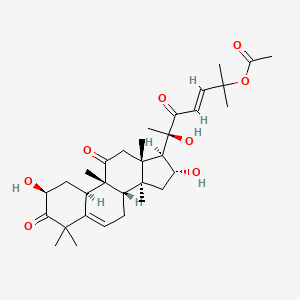| MeSH term | MeSH ID | Detail |
|---|---|---|
| Lung Neoplasms | D008175 | 171 associated lipids |
| Carcinoma, Non-Small-Cell Lung | D002289 | 72 associated lipids |
Cucurbitacin B
Cucurbitacin b is a lipid of Sterol Lipids (ST) class. Cucurbitacin b is associated with abnormalities such as Morphologically altered structure. The involved functions are known as Signal Transduction, Apoptosis, Cell Cycle Arrest, Cell Cycle and Negative Regulation of Mitosis. Cucurbitacin b often locates in Mediastinum and Pseudopodia. The associated genes with Cucurbitacin B are STAT5A gene, JAK2 gene, STAT3 gene, CDKN1A gene and BCL2L1 gene. The related experimental models are Xenograft Model.
Cross Reference
Introduction
To understand associated biological information of Cucurbitacin B, we collected biological information of abnormalities, associated pathways, cellular/molecular locations, biological functions, related genes/proteins, lipids and common seen animal/experimental models with organized paragraphs from literatures.
What diseases are associated with Cucurbitacin B?
Cucurbitacin B is suspected in Morphologically altered structure and other diseases in descending order of the highest number of associated sentences.
Related references are mostly published in these journals:
| Disease | Cross reference | Weighted score | Related literature |
|---|
Possible diseases from mapped MeSH terms on references
We collected disease MeSH terms mapped to the references associated with Cucurbitacin B
PubChem Associated disorders and diseases
What pathways are associated with Cucurbitacin B
Lipid pathways are not clear in current pathway databases. We organized associated pathways with Cucurbitacin B through full-text articles, including metabolic pathways or pathways of biological mechanisms.
Related references are published most in these journals:
| Pathway name | Related literatures |
|---|
PubChem Biomolecular Interactions and Pathways
Link to PubChem Biomolecular Interactions and PathwaysWhat cellular locations are associated with Cucurbitacin B?
Visualization in cellular structure
Associated locations are in red color. Not associated locations are in black.
Related references are published most in these journals:
| Location | Cross reference | Weighted score | Related literatures |
|---|
What functions are associated with Cucurbitacin B?
Related references are published most in these journals:
| Function | Cross reference | Weighted score | Related literatures |
|---|
What lipids are associated with Cucurbitacin B?
There are no associated biomedical information in the current reference collection.
What genes are associated with Cucurbitacin B?
Related references are published most in these journals:
| Gene | Cross reference | Weighted score | Related literatures |
|---|
What common seen animal models are associated with Cucurbitacin B?
Xenograft Model
Xenograft Model are used in the study 'Cucurbitacin B induces apoptosis by inhibition of the JAK/STAT pathway and potentiates antiproliferative effects of gemcitabine on pancreatic cancer cells.' (Thoennissen NH et al., 2009).
Related references are published most in these journals:
| Model | Cross reference | Weighted score | Related literatures |
|---|
NCBI Entrez Crosslinks
All references with Cucurbitacin B
Download all related citations| Authors | Title | Published | Journal | PubMed Link |
|---|---|---|---|---|
| pmid: | ||||
| Peters RR et al. | Anti-inflammatory effects of the products from Wilbrandia ebracteata on carrageenan-induced pleurisy in mice. | 1999 | Life Sci. | pmid:10403502 |
| Raikhlin-Eisenkraft B and Bentur Y | Ecbalium elaterium (squirting cucumber)--remedy or poison? | 2000 | J. Toxicol. Clin. Toxicol. | pmid:10866331 |
| Oberlies NH et al. | Bioactive constituents of the roots of Licania intrapetiolaris. | 2001 | J. Nat. Prod. | pmid:11325234 |
| Litaudon M et al. | Morierinin: a new cytotoxic cucurbitacin from the leaves of Morierina montana Vieill. | 2003 | Nat. Prod. Res. | pmid:12822899 |
| Toker G et al. | Callus formation and cucurbitacin B accumulation in Ecballium elaterium callus cultures. | 2003 | Fitoterapia | pmid:14630164 |
| Wu PL et al. | Cytotoxic and anti-HIV principles from the rhizomes of Begonia nantoensis. | 2004 | Chem. Pharm. Bull. | pmid:14993759 |
| Clericuzio M et al. | Cucurbitane triterpenoids from Leucopaxillus gentianeus. | 2004 | J. Nat. Prod. | pmid:15568769 |
| Agil A et al. | Isolation of ani-hepatotoxic principle form the juice of Ecballium elaterium. | 1999 | Planta Med. | pmid:15609462 |
| Chen JC et al. | Cucurbitacins and cucurbitane glycosides: structures and biological activities. | 2005 | Nat Prod Rep | pmid:16010347 |
